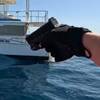On April 18, Rear Admiral Anthony “Jack” Vogt, Assistant Commandant for Response Policy, released an update on the status of the most recent U.S. Salvage and Marine Firefighting (SMFF) industry verification initiative. According to the report, the Coast Guard has conducted 58 scenario-based SMFF verifications within the last year across 19 different Captain of the Port Zones, with 16 different vessel owners and operators. To date, all results have been found to be satisfactory and reflect compliance with the Coast Guard’s Salvage and Marine Firefighting regulations.
“The latest report from the Coast Guard on the marine salvage industry’s exceptional performance and continued compliance with the regulatory planning standards is a testament to our dedication and commitment to continuous improvement of the U.S. and international emergency response capabilities,” said Jim Elliott, President of the American Salvage Association. “To be honest, this positive Coast Guard report tarnishes the validity of a recent paper by a special interest that the American Salvage industry lacks the required capabilities to respond to a marine casualty in U.S. waters within the planning standards.”
The promulgation of the SMFF regulations consequently resulted in a significant investment by the U.S. salvage industry in building a national response posture that could meet the stringent regulatory planning standards. Today, American Salvage Association companies continue to expand their capabilities and fill critical response infrastructure gaps that fall outside of the nineteen specified SMFF services. “The U.S. salvage industry’s phenomenal response to the historic 2017 hurricane season is just another testament of the industry’s capacity – simultaneously salvaging hundreds of ships, barges and boats in multiple locations following three hurricane landfalls, all while continuing to effectively meet the regulatory standards for salvage and marine firefighting” said Mr. Elliott.
When the Oil Pollution Act of 1990 was promulgated, vessel owners and operators were mandated to maintain a Vessel Response Plan (VRP) that listed a “salvage company…” and “a company with firefighting capability…” During this time, there were no regulatory qualifications for VRP-listed salvage companies, no definitive services required, and the timeframe for response fell within an easily achievable twenty-four hours. Due to the nature of the original salvage and marine firefighting requirements, hundreds of so-called salvors were listed within Vessel Response Plans,many of which had questionable capability and expertise.
Vessel Response Plan requirements changed drastically with the implementation of the salvage and marine firefighting (“SMFF”) regulations for tank vessels in 2008 and non-tank vessels, 400 gross tons and over, in 2013. Now, in order to be listed in a VRP, salvors must meet fifteen pre-defined selection criteria, establish a pre-negotiated funding agreement with a plan holder, and must present a validated plan to respond within the specified timeframes for nineteen distinct services.
During the regulatory implementation process, the U.S. Coast Guard established a thorough verification program ultimately narrowing the field of qualified salvors from hundreds to just four national salvage companies and a handful of regional salvage providers. However, the verification process did not end with this thorough top-to-bottom review. SMFF service providers were, and are still today, continuously audited by vessel owners, operators, and regulatory authorities during plan preparation, a multitude of drills and exercises including full scale deployments, and daily commercial operations.
In an effort to follow up on the initial round of assessments, the Coast Guard implemented a new and more rigorous verification program in April of 2016. Still ongoing today, the objective of the new initiative is to ensure that SMFF service providers can meet the planning and capability standards outlined within the regulations and can deliver said resources and services within the defined planning timeframes.
“The American Salvage Association is fully committed to continuing to work with the Coast Guard, vessel owners and operators, insurers, and other stakeholders to achieve regulatory compliance within an evolving policy landscape,” noted ASA President, Jim Elliott. “In the end, I believe we all share the common goals of promoting life safety, minimizing environmental impacts and quickly saving ships and cargo.”










